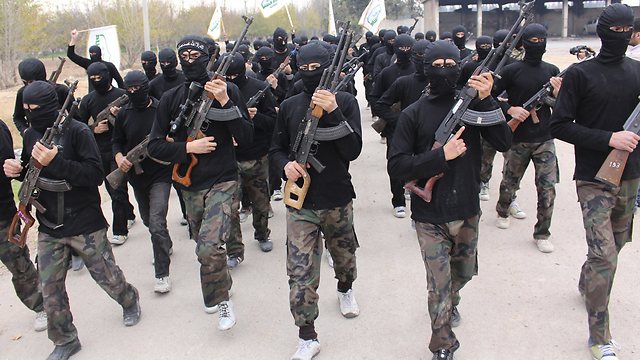ISIS: The product of Syria’s cult culture?
Tuesday, 9 December 2014
Dr. Halla Diyab/Al Arabiya
The poignancy of the deadlock in the Syrian crisis was summed up by Kofi Annan at Geneva Palais des Nations at the end of June 2012. “History is a somber judge,” he said, “and it will judge us all harshly if we prove incapable of taking the right path today.” The right path is not to “wield tremendous power and change the direction of [the] crisis” as Annan puts it but rather to exert power to create a political leadership that can pull the country together.
The stalemated nature of the Syrian crisis bizarrely fed the culture of cults in the country because the Syrian crisis tossed the country into two extreme cults, or factions. The international community cannot keep watching the Syrian bloodshed without doing anything otherwise the humanitarian disaster will get worse. Also, the risk of a U.S. airstrike on Assad’s regime could jeopardize the relative political stability in Damascus. It also seems that in the absence of an alternative to Assad on the ground, Damascus could fall in the hands of ISIS or the armed militias who will unleash chaos similar to the Libyan scenario. As more arms and ammunitions reach the Syrian rebels, there is a high possibility they will also reach the extremists among the rebel factions as well.
“The ISIS cult started as a trend adopted by those who were “going over” to stop the killing of their fellow Muslims”
However, pursuing diplomacy and political solutions means more time is given to Assad to strengthen his domestic power and more exhaustion of the Syrian infrastructure will occur. People are getting desperate and are looking for any hope to end the crisis. The Syrian crisis fails to empower community leadership as a mechanism of survival and the only way left for people is to be divided according to their political, sectarian and religious loyalties. Some wish to belong to a cult that can secure their survival.
The four-year conflict has produced a leadership that is sustained by a culture predicated on the supposed right to be violent and the right to kill. The harsher and more bloody the leader can be, the more chances he will have to survive in power. Driven to the extreme, the leadership takes the form of a cult and this provokes doubts on the subjectivity of the leadership born out of the Syrian revolution. It also brings out doubts on the longstanding binary opposition of good vs. evil, strong vs. weak, innocent vs. guilty and heroes vs. criminals.
Assad’s cult
Assad’s cult is more personal and individualistic. Bashar al-Assad is not keen on the cult of personality and his dislike of his father’s fascination with statues implies that Assad is innately reprogramming Hafez’ personality cult of totalitarianism into a cult grouping of the Assad aides, domestic allies and siblings favorites. The security services and the palace’s protocol office are in charge of Bashar’ public image.
The rise of the Islamic fundamentalist cult of ISIS is not only the result of political chaos in Syria, the prolonged civil war and the collapse of secular nationalism but is also due to the inability of people in Syria to participate in the political spectrum and be loyal to Assad’s “cult”. People pursue ways of identifying themselves, becoming allied with others and participating in something they can be part of. With people’s inability to participate in public sphere, or in functional political organizations, they find in religious fundamentalism a way out.
The ISIS cult started as a trend, a fashion of those who were “going over” to stop the killing of their fellow Muslims. Soon they were transformed into savages and intruders who beheaded Syrians in their homeland. ISIS as a cult is not only a product of a barbaric war that has been brutalizing people throughout the last four years, but is also a product of Assad’s cult of personality. ISIS is not an intruder cult but the product of the very society which witnessed its rise. When people are suppressed and dehumanized in the fascist pyramid of state power, they are transformed into perpetrators themselves, they become agents of suppression the moment they are liberated being at the bottom.
The ISIS cult
Unlike the Assad cult, the ISIS cult operates upon patterns of religious ideological lines. They identify with signs, flags, idioms and emblems. The external façade of their barbaric ruthlessness, limitless violence and hostility is based upon their own self-made fantasy that they are soldiers who pubish those who oppose their ideology.
Unlike Assad’s cult, which seeks the continuity of the dynasty and the power of Assad’s family, for ISIS it is the territorial existence of their fanatic narrative which offers them hope, acceptance and an identity. While survival is at the core of Assad’s cult, death is the ISIS cult’s main cause. The self-proclaimed Caliph, Abu Bakr al-Baghdadi, sacrifices ISIS cult followers for the cause. As with other cults, the ISIS cult draws people to fear, obedience and ultimate sacrifice.
They put their life in the hands of a man who will decide their destiny. ISIS cult followers are willingly and voluntarily besieged in order to be closer to the cult and to be cut off from the outside world.
The ISIS cult will never develop into a deep-rooted religion, everlasting ideology or a solid state. It will gradually collapse into a tragedy or to a disaster. A very similar example is Guyana 1977, as Jim Jones dragged his cult in Jonestown to self-destruction so will Abu Bakr al-Baghdadi.






















